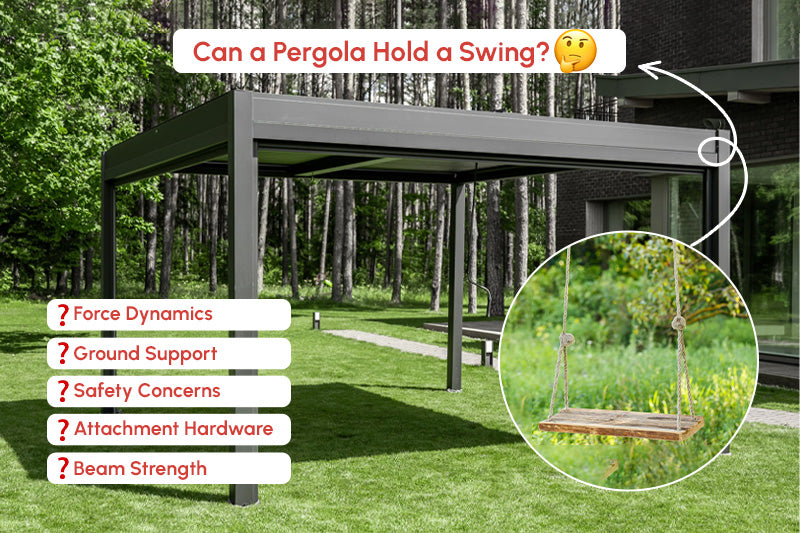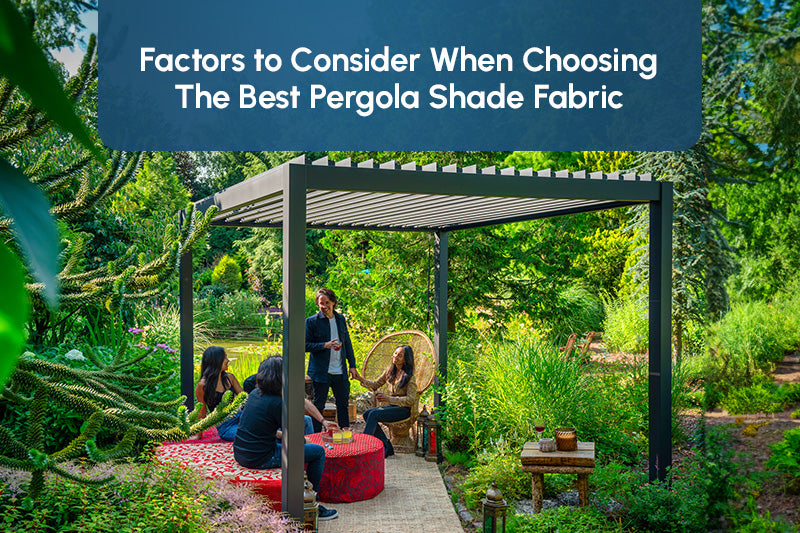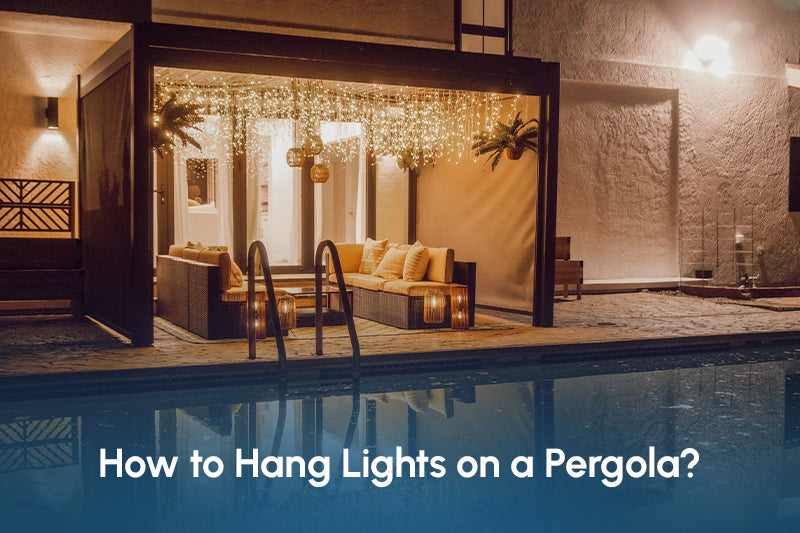Can a Pergola Hold a Hammock or Swing?
The quick answer:
No, generally, not advisable to put a swing or hammock on a pergola structure.
It doesn't mean that the pergola can't hold a hammock or swing, but you need to pay attention to some major details.
First of all, you have to go through some key technical considerations.
Before you rush out to hang up your hammock or attach that swing, there are some crucial points to consider, which we will discuss in this article.
Can a Pergola Hold a Hammock?

A pergola can provide the perfect space to hang a hammock, but not all pergolas are built to hold a hammock and it is not advisable by the manufacturers as well.
There are crucial technicalities to consider before diving in.
Let's explore some critical points:
-
Weight Rating: Most pergolas, especially the standard wooden ones or those made for a small yard, might not have been constructed with the idea of supporting a hammock's weight. The dynamic force when getting into or out of a hammock can greatly increase the weight exerted. So, the weight rating of the pergola posts and beams becomes paramount and they vary depending on material, size and design choices.
-
Structural Support: A typical pergola's beams and columns might not be designed to handle the lateral and vertical forces exerted by a hammock, especially when in use. You might notice some pergolas start to bow inwards over time if not appropriately reinforced.
-
Spacing of Posts: The distance between pergola beams and louvers is another concern. A large hammock requires more space to hang properly without touching the ground. If your pergola's columns are too close together, your hammock might not fit or, worse, might hang too low.
-
Attachment Points: Where and how you attach your hammock to the pergola is crucial. Simple screws or nails might not be sufficient. Professional-grade anchors or hooks designed for significant weight and stress will offer more security and safety, if the weight rating allows.
-
Dynamic vs. Static Weight: A static hammock, one where you just lie down and relax, exerts less stress than when you swing or move dynamically. If you've attached fairy lights or added pillows, the dynamic weight can change drastically, so always account for the maximum possible weight.
Can a Pergola Hold a Swing?

Continuing from the hammock consideration, let's delve into the prospect of adding a swing to your pergola.
It's tempting to visualize a gentle swing in your outdoor living space, catching the sun, and providing moments of relaxation.
But just like with hammocks, there are technical hurdles to navigate:
-
Force Dynamics: Unlike a hammock, a swing introduces a consistent back-and-forth dynamic force. This repeated force can stress the pergola posts and potentially lead to structural weaknesses over time, especially if the material isn't resilient like modern aluminum.
-
Ground Support: The force exerted by a swing isn't just on the pergola's beams or roof structure but also translates downwards to the pergola's columns and the ground. This can result in pergola posts shifting or even detaching from their foundational supports.
-
Safety Concerns: Swings, especially when used vigorously or by children, pose a higher risk of accidents if the pergola isn't designed to handle the weight and movement. The last thing anyone would want is a sudden collapse during a fun family moment.
-
Attachment Hardware: Just like hammocks, the type of hooks, screws, and other hardware you use to hang the swing becomes essential. Standard attachment methods might not suffice. Opting for heavy-duty, professional-grade anchors is always a safer bet.
-
Beam Strength: The central beam, where most homeowners would ideally want to attach their swing, experiences the most stress. Over time, this could lead to the beam bowing inwards, if it's not supported or reinforced by posts or weight load exceeds.
How Much Weight Can a Pergola Hold?

The weight a pergola can support largely depends on several factors, making it a bit challenging to give a one-size-fits-all answer.
An aluminum pergola can hold an estimated load of 8-15 pounds per square foot depending on the quality of aluminum used.
However, you need to consider again some factors:
-
Material Matters: As mentioned, the pergola's material plays a significant role in its weight-bearing capacity. For instance, while wood has a certain rustic charm, its weight-bearing capacity might differ from that of an aluminum pergola. Aluminum, being both lightweight and sturdy, often offers higher durability.
-
Ground and Foundation: The stability of a pergola isn't just about its roof or beams. How well it's anchored to the ground is paramount. Pergolas anchored in concrete footings will generally bear more weight than those simply placed atop a garden's soil.
-
Post Size and Spacing: The thickness and spacing of pergola posts can influence weight capacity. Larger, well-spaced posts can distribute weight more effectively, preventing undue stress on any single point.
-
Maintenance History: Regular upkeep, like checking for rot in wood or ensuring screws and bolts are tightened, can impact a pergola's weight-bearing ability. A well-maintained pergola is more likely to hold weight securely.
-
Dynamic vs. Static Loads: As touched upon earlier, there's a difference between a static load (like hanging plants or fairy lights) and dynamic loads (like swings or hammocks). Understanding this difference is crucial when gauging weight limits.
How Stable is a Pergola in General?
A pergola is not just a stylish addition to your backyard or outdoor living space; it's also a structure that demands stability.
But, the pressing question is: how steady is that inviting shade-creator, really?
Well, it depends a lot on the foundation upon which your pergola stands plays a pivotal role.
The anchoring depth and method play pivotal roles.
Pergolas anchored deep into the ground with robust concrete footings stand as unwavering sentinels against the test of time and elements.
These aren't just simple holes in the ground; they're the very foundation ensuring that the pergola posts remain upright and sturdy. And it's not just about depth; the quality of the material used for anchoring, like reinforced concrete, further adds to this stability.
However, there's a game-changer in the pergola world: aluminum pergolas.
These modern structures, known for their lightweight yet durable nature, don't demand deep anchoring.
Instead, they can be anchored using specially designed brackets affixed to concrete pavers. This unique anchoring system not only simplifies installation but also ensures a sturdy and rock-solid foundation.
Alternative Strategies for Placing a Hammock and Swing Under a Pergola

So, you're set on creating that dreamy oasis in your backyard, aren't you?
A place where the gentle sway of a hammock invites relaxation or where a swing becomes the centerpiece for fun family moments.
But if direct attachment to the pergola posts raises eyebrows, what are your options?
1. First, think of additional or independent support.
Why not introduce additional support beams specifically designed for the hammock's weight rating?
These could be firmly rooted into the ground, ensuring stability. They'd act much like the sturdy columns of a pergola, offering a dedicated space for your hammock or swing. Plus, it retains the visual charm.
2. Another idea is utilizing a freestanding hammock stand or swing frame.
Trust us, it will be way safer. Positioned under the pergola, they'll offer the illusion of being part of the pergola structure, but with the assurance of safety.
You get the best of both worlds: the shade of the pergola and a safe, relaxing hammock experience.
Conclusion
While the idea of adding a hammock or a swing can be tempting, especially under the shade of a modern aluminum louvered pergola, it's essential to understand the underlying structural intricacies.
With technical considerations, professional guidance, alternative strategies, and a keen understanding of your pergola's foundation, you can craft a space that's both enchanting and safe.
One of the safest methods is to have a freestanding hammock or swing frame under your pergola.
If you are not sure, before placing a hammock or swing on your pergola, consult a structural engineer or other specialist to assess its safety and integrity. We are not liable for any damages or injuries caused by hanging a hammock or swing from a pergola.





